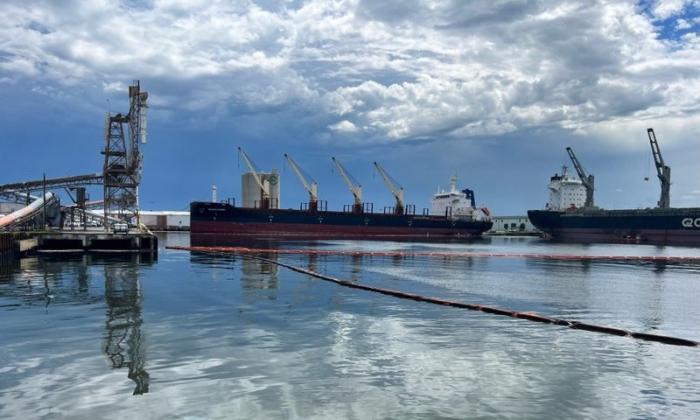Coast Guard officials are still investigating an oil spill at SeaPort Manatee that contaminated 20,500 gallons of seawater and required an 11-day cleanup operation in early September.
In a joint effort with the National Response Center (NRC) and SeaPort Manatee, the U.S. Coast Guard deployed 4,000 feet of “boom,” or floating barriers used to collect oil from the water’s surface, along with absorption and vacuuming procedures.
Roughly 3,500 gallons of water contained a “very heavy, unrefined oil,” according to Captain Michael Kahle, Sector Commander for the Coast Guard, who is investigating the case.
Officials sent oil samples for type testing to determine the source of the contamination.
“With no evidence pointing to any infrastructure failures or pipeline leaks so far, it looks increasingly likely that someone may have dumped this oil and is failing to come forward,” U.S. Congressman Vern Buchanan (R-Fla.) said during a tour of the port on Sept. 8 after officials collected 97 percent of the surface oil from the water.
“Whether an accident or purposeful, any potential bad actors must be held accountable for putting our waterways at risk.
“Just as water quality is critical to our way of life, Port Manatee is essential to our area’s economy, and I’m committed to ensuring both are safeguarded from future spills,” Mr. Buchanan continued.

According to the Coast Guard, the “source and responsible party” are still under investigation. By Sept. 11, officials had cleaned 99 percent of the area, including multiple ship hulls and portions of the retaining sea wall.
SeaPort Manatee executive director Carlos Buqueras commented on environmental impacts in a statement.
Trouble Lurking On Water
SeaPort Manatee is a deepwater seaport owned by Manatee County and located at the mouth of Tampa Bay.As one of Florida’s largest deepwater seaports, it is also the country’s closest seaway to the Panama Canal.
Officials from SeaPort Manatee discovered the oil spill on Aug. 31 amid routine Coast Guard inspections following the port’s closure during Hurricane Idalia.

The Coast Guard was poised to reopen the port before identifying the oil spill.
After notifying the response center, Coast Guard officials initially deployed 1,400 feet of water containment “boom,” floating barriers used to collect marine spills.
The Coast Guard also utilized absorption and vacuuming equipment to contain the spill.
“About 15 tons of contaminated debris and contaminated absorbent materials are being properly disposed of. This [is] equivalent to about two African male elephants. The source and responsible party are under investigation,” the Coast Guard said in a statement on Sept. 4.
The Coast Guard cleaned thousands of gallons of contaminated water each day and removed oil from ship hulls and the sea wall around the port.

“Additional samples were taken from three vessels and two pipeline companies for analysis to attempt to find a match to the spilled oil,” the Coast Guard said in a statement on Sept. 7.
A pigeon was discovered in oil collected from the booms but was rescued and released by wildlife officials.
By Sept. 8, testing confirmed the oil as “heavy fuel oil,” typically created during the refinement of crude oil.
Further testing is underway to “determine the oil type to attempt to identify a source,” the Coast Guard said.
Of the 19,000 gallons of contaminated sea water-oil mixture cleaned from the port, 3,500 gallons contained “very heavy, unrefined oil,” according to Mr. Kahle.
Mr. Buqueras stressed that it is “still too early to define where exactly that heavy fuel came from because we don’t handle a lot of heavy fuel” at the port.

Environmental Impacts
SeaPort Manatee reopened on Sept. 11 following confirmation from the Coast Guard that 99 percent of the site was cleaned.While Coast Guard officials and the NOAA insisted that there were no immediate ecological concerns to the bay and surrounding area, Tampa Bay Waterkeeper—a grassroots organization fighting for the “right to clean water” in the Tampa Bay ecosystem—disagreed.
“You know, it’s hard to imagine that there’s no environmental impact of an oil spill,” executive director Justin Tramble told The Epoch Times.
“I mean, if I spilled oil in my front yard, there would be an environmental impact. So it’s hard to believe that there’s no environmental impact.”
Mr. Tramble noted the proximity of SeaPort Manatee to the Piney Point phosphate plant, a fertilizer and wastewater treatment facility that had to be forcibly drained in April 2021 after leaks to the reservoir’s liner threatened to unleash a tsunami-like wall of water into the surrounding area.
Officials evacuated more than 300 homes and businesses as Governor Ron DeSantis mobilized the Florida Department of Environmental Protection (DEP), the National Guard, and Manatee County officials to drain roughly 30 million gallons of wastewater daily out of the reservoir and into Tampa Bay, according to a report from the Herald Tribune.
The effort relieved pressure on the reservoir’s internal walls and prevented catastrophic failure, officials said. They reduced the facility’s 480 million gallons of wastewater to 300 million in a week.
Officials said the project stopped the destruction of nearby homes and businesses and prevented wastewater contamination in nearby Bishop Harbor, which has strict ecological protections with its “Outstanding Florida Water” designation.
The Florida DEP has categorized certain rivers, lakes, and bodies of water as such if they are “worthy of special protection because of their natural attributes.”
Unintended Consequences
Piney Point’s wastewater was drained directly into Tampa Bay—and while plans are underway to close the facility for good—more wastewater had to be drained in August after prolonged rainfall from Hurricane Idalia, according to reports from the plant.Mr. Tramble said he was worried about the cumulative effects of these chemical contaminants in the fragile Tampa Bay ecosystem and how many “hits” the aquatic estuary can weather before facing a serious environmental catastrophe.

It’s not just about protecting the wildlife and ecology, Mr. Tramble said; it’s also about ensuring economic prosperity for the entire Tampa Bay area.
“What we are steadfast in defending is how important water quality is to the economic impact of the region,” he said.
He pointed to recent data from the Tampa Bay Regional Planning Council indicating that clean water accounts for one in 10 jobs across the Tampa Bay region.
Ed Sherwood, executive director of the Tampa Bay Estuary Program, agreed.
“Tourism and marine construction contribute nearly 58 percent of that $32 billion economic output. If the bay degrades and healthy habitats go away, or we do a poor job of protecting the quality of our environment, then it’s likely we’ll adversely impact those sectors in the future,” he said in a statement.
Mr. Tramble explained how, historically, the concerned advocates for clean water were often at odds with those supporting industry and unrestrained economic growth.
“When you start to look at this data, and you start to realize the economic impact of what clean water is, you realize that both of these things should work together,” he said.
“I think what is happening is people are starting to tie economic impact to clean water. And in the past, maybe industry and clean water were on separate sides of some sort of proverbial aisle,” Mr. Tramble said.
“That shouldn’t be the case anymore. I think there is no question that clean water is absolutely an integral part of the sustainability of Tampa Bay and the region.”
Moving Forward
As for Piney Point, the University of South Florida reported in July that plans are still underway to close the phosphate plant. In April, a deep injection well was dug to discharge wastewater below the drinking water aquifer at roughly 700,000 gallons a day.Herb Donica, a court-appointed receiver tasked with closing the aging phosphate gypsum stacks, told USF that Piney Point should be closed within 18 months.
Afterward, the empty stacks will be “covered with a thick sheet, with two inches of dirt and grass above that.”
Gov. DeSantis ordered the site’s closure after averting catastrophic failure in 2021. The state of Florida has spent roughly $185 million on closing the plant, according to USF’s report.







